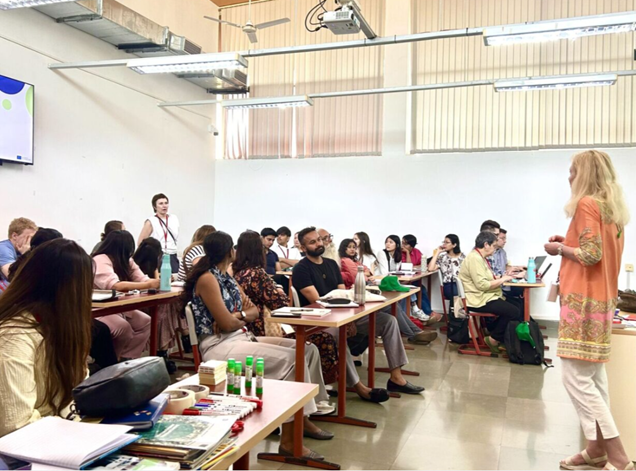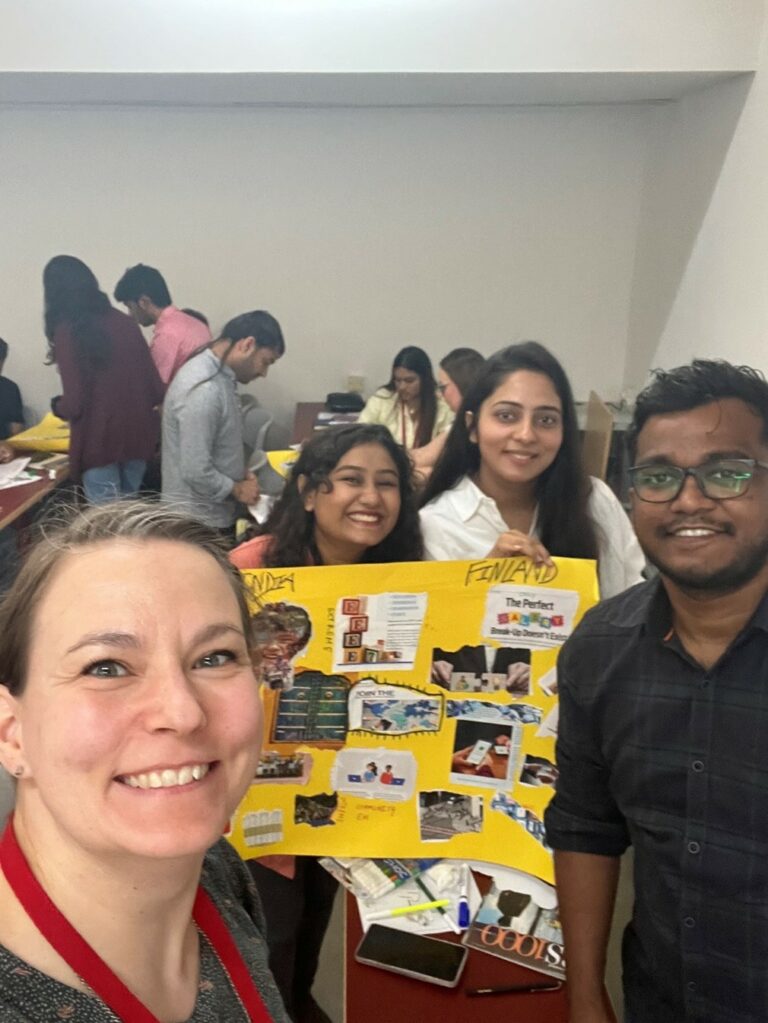In Laurea’s Future-Oriented Project Management program, students gained valuable knowledge and experience in international and multicultural project work. During spring 2024, service design and co-creation studies related to the program were carried out at the Leppävaara campus as part of the Co-Life and CeMe We projects. A group of 71 students from Finland and India participated. The student teams developed solutions to the project objectives through live projects focused on impact-driven entrepreneurship. Methods from research-based development, service design, co-creation, and project management were applied throughout the work.

Photo by Johannes / Adobe Stock (Laurea Education-licence)
In January 2025, three Laurea students and one teacher had the opportunity to travel to the Goa Institute of Management in India to pilot a new study module being developed as part of the Co-Life project. The project includes eight partners in total, with participating higher education institutions from Finland, Denmark, Belgium, and India.
Key Features of Multicultural Teamwork
Understanding the opportunities and specific characteristics of multicultural teamwork was an essential part of the study module piloted in India. The collaboration began with familiarization with multiculturalism and mutual mapping of expectations. Tiina Lehtosaari gave a lecture to the student group, emphasizing the importance of understanding human diversity in project management and teamwork, and how diverse perspectives and competencies enrich collaboration. She also pointed out how people tend to view their own culture as the baseline for cooperation.
The lecture covered aspects such as different work-related lunch customs, where hierarchy plays a role — for instance, it’s not always customary to sit at the same table with company executives. It was noted that corporate cultures are context-dependent, and the level of hierarchy varies by industry and company size. Globally, Generation Z values equality, and one aspiration voiced by Indian students was that people should be referred to by their first names in the workplace. Last names can still indicate caste in India, which may lead to subtle discrimination.
Following the lecture, a workshop was held where students discussed their experiences with multiculturalism in groups. Each group created a mood board representing their reflections and presented it to others. Cultural perspectives emerged around leadership styles, giving and receiving feedback, and management expectations. Indian students also shared their experiences of multiculturalism within India itself — a vast country with many cultures, religions, and languages — where interacting across cultural boundaries is a part of daily life. “Finland’s two official languages and one dominant religion don’t automatically create the same kind of multicultural foundation or learning opportunities,” commented Tiina Mustonen.
Cultural differences were also evident in study habits. Indian students demonstrated high motivation and a fast-paced rhythm. They attend full-day lectures, take naps or breaks between 5 and 7 p.m., have dinner between 8 and 10 p.m., and then often continue studying until 3 a.m. the next morning — starting again at 9 a.m. Goa Institute of Management also hosts voluntary study circles focused on marketing, data analytics, campus development, and sports in the evenings.

Image 1. Tiina Lehtosaari giving a lecture
Home Turf Advantage in Project Work
“It was fascinating to see how much home field advantage affects team roles in joint work,” said Katja Lajunen. “At the Leppävaara campus, Finnish students almost automatically assumed the role of project leads. I believe this was due to the Indian students, who arrived mid-winter and were unfamiliar with Finnish work and social culture, needing more support in adapting to local study methods.”
When the Finnish students in turn entered a different culture with new working methods, the roles reversed. “The locals immediately took charge of project leadership,” said Matilda Pontán. “It was our turn to be a bit lost and in need of support.” Indian students had the advantage of language fluency and cultural familiarity, placing the international students in a more dependent role.

Image 2. Smiling students
Lessons in Project Work and Human Interaction
Research has extensively examined project team performance, showing that the best outcomes are achieved when the project team operates as a cohesive unit aligned with project goals (Baiden, 2006; Chervier, 2003; Ochieng & Price, 2008).
Despite technological advancements and improved data transfer, communication challenges in multicultural teams have remained constant (Emmitt & Gorse, 2007). Project success is particularly challenged when multicultural teams are geographically dispersed and when team members come from different organizational and local cultural backgrounds. For example, the loss of face-to-face communication may lead to misunderstandings when nonverbal signals like eye contact and body language are missing. This makes trust-building in multicultural teams more difficult (Weatherley, 2006).
The Co-Life project took this into account by beginning with one week of face-to-face collaboration. Virtual teamwork continues among the groups, testing the trust and team spirit developed during that initial week.
There is much Finnish people could learn from Indian culture. Always smiling and cheerful, Indians take care of one another, and things tend to resolve through community spirit. They don’t take themselves too seriously either — dancing freely at parties and singing on bus rides, even if the lyrics aren’t remembered or the voice cracks. “At Goa Institute of Management, we were consistently greeted with warm smiles,” said Tiina Mustonen. “The feeling that people are genuinely interested in you gives a great foundation for teamwork.”
The Co-Life project pilot will continue until March 2025, when participants will meet again — this time in Mumbai — to present their collaborative projects to local business partners. Smiles and open-minded encounters would surely warm the hearts of international students arriving in Finland in the middle of winter. We have much to learn about internationalization and meeting people without prejudice. It is wonderful that Laurea students gain firsthand experience in multiculturalism and international cooperation through their studies. Finnish companies should also learn to embrace multiculturalism to thrive in international markets. Research shows that multicultural teams add value to projects. These collaboration skills will be increasingly essential in the future workplace.
Follow the progress of the Co-LIFE project here:
References
- Baiden, B.K., 2006. Framework of the Integration of the Project Delivery Team. Unpublished Ph.D. Thesis, Loughborough University.
- Chervier, S., 2003. Cross-cultural management in multinational project groups. Journal of World Business, 38, 141–149.
- Emmitt, S., Gorse, C.A., 2007. Communication Construction Teams. Taylor and Francis, Oxon.
- Ochieng, E.G., Price, A.D.F., 2009. Managing cross-cultural communication in multicultural construction project teams: The case of Kenya and UK. International Journal of Project Management, 28(5), 449–460.
- Weatherley, S., 2006. ECI in Partnership with ECITB, ECI UK 2006 Master class: Multicultural Project Team Working, London, 6 December 2006.
The first image in this article (the feature image) is not licensed under CC BY-SA. It has been used in accordance with the terms of the Adobe Stock Education License and may not be reused or redistributed without separate permission.